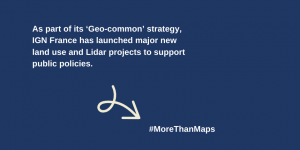National Institute of Geographic and Forest Information (IGN) France
“The fact that IGN’s data are free of charge since 1 January 2021 reinforces IGN’s mission of pooling public players in the field of sovereign data. The challenges for IGN are thus to produce data useful to public players, by bringing them together in joint projects, such as the national Lidar HD programme and large-scale land use. The code name ‘Geo-common’ refers to this strategic orientation of IGN as a common resource, pooling and working with communities according to a participatory logic.”
Sébastien Soriano, Director General, National Institute of Geographic and Forest Information (IGN) France
As part of its ‘Geo-common’ strategy, IGN France has launched major new land use and Lidar projects to support public policies. These include the national high-density Lidar coverage programme and the national soil artificialisation observatory.
At the same time, the IGNfab incubator aims to accelerate startups’ digital geoservice projects that use location data and land description. Indeed, usages of innovative data such as high-definition Lidar data have to be supported and fostered. As part of its last theme-based call for projects, dedicated to “Energy and climate change” and issued in 2020, IGNfab helps and supports the developments of 5 projects linked to building energy renovation.
National Lidar programme
In the framework of its brand new national Lidar programme, IGN France will acquire, compute, host and broadcast Lidar point clouds at high density (10 points per square meter). The French public bodies responsible for natural risks prevention, forest management and agriculture are providing the first case studies.
Benefits
- Enables fine, quasi-synchronous and homogeneous three-dimensional knowledge of the topographic soil, artificial topsoil and vegetation between 2021 and 2025.
- Generates classified Lidar point clouds and very precise Digital Terrain Models (DTMs) and Digital Surface Models (DSMs).
- Can be used for a wide range of applications in a variety of public policies, such as spatial planning, agriculture, forest, energy, biodiversity, and climate.
National soil artificialisation observatory
The Ministry for Ecological Transition requested a project of large-scale land use and land cover for the measurement of soil artificialisation. This project aims to produce a reference framework for land occupation and use throughout the national territory, through automated processes based on artificial intelligence. The objective is to disseminate open data on soil artificialisation.
Benefits
- Enables the State and the territories to combat urban sprawl, which reduces the capacity of agricultural land to feed us, increases the distances travelled by individuals, increases expenditure on networks (roads, electricity, sanitation, etc.), accelerates the loss of biodiversity by fragmenting spaces and, due to soil sealing in particular, increases the risk of flooding.
- Provides an essential brick in reaching the ‘Zero net artificialisation’ objective, recalled by the President of the Republic before the Citizens’ Convention for the Climate on 29 June 2020.
- Delivers objective data to public (State, local authorities) and private (consultancy firms, urban planning agencies, etc.) players for combating soil artificialisation.
- Promotes a shared diagnosis of the process of soil artificialisation, for the preservation of biodiversity, food autonomy and the fight against global warming.

